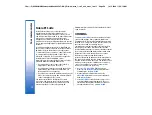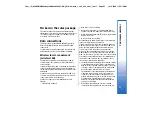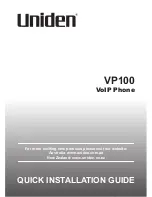
Stickers in the sales package
The stickers in the sales package contain important
information for service and customer support purposes.
The sales package also includes instructions on how
you should use these stickers.
Data connections
This device supports packet data (GPRS), high-speed
data calls (HSCSD), GSM data calls, and wireless LAN
connections.
For information on packet data, high-speed data calls,
and GSM data calls, see the User Guide on CD-ROM.
Wireless local area network
(wireless LAN)
There may be restrictions on using wireless LAN in
some locations. Check with your local authorities or
service provider.
Features using wireless LAN, or allowing such features
to run in the background while using other features,
increase the demand on battery power and reduce the
battery life.
Your device is approved for use in a wireless LAN. You
can use wireless LAN to send and receive e-mail, and
connect your device to the Internet.
Your device supports the following wireless LAN
features:
• IEEE 802.11b standard
• Data rates of up to 11 Mbit/s
• Operation at a frequency of 2.4 GHz using direct
sequence spread spectrum (DSSS) radio technology
• Wired equivalent privacy (WEP) data encryption with
keys up to 232 bits.
• Wi-Fi protected access (WPA)
Note that the WEP and WPA functions can be used only
if they are supported by the network.
If you move the device to another location within the
wireless LAN and out of range of a wireless LAN access
point, the roaming functionality can automatically
connect your device to another access point that
belongs to the same network. As long as you remain
within range of access points that belong to the same
network, your device can stay connected to the network.
Your device enables different types of communication
in a wireless LAN. There are two operating modes to
choose from: infrastructure and ad hoc.
• The infrastructure operating mode allows two kinds
of communication: wireless devices communicate
with each other through a wireless LAN access point
or wireless devices communicate with a wired LAN
device through a wireless LAN access point.
The advantage of the infrastructure operating mode
is that you can have more control over network
connections because they pass through an access
point. A wireless device can access the services that
are available in a regular wired LAN: company
database, e-mail, the Internet, and other network
resources, for example.
• With 3rd party applications, you can send and
receive data directly with each other in the ad hoc
25
Your communicator
file:///C:/USERS/MODEServer/tkoikkal/864507/RA-2_Erin/en/issue_1/ra-2_erin_en-us_1.xml
Page 25
Jul 2, 2004 11:32:12 AM
file:///C:/USERS/MODEServer/tkoikkal/864507/RA-2_Erin/en/issue_1/ra-2_erin_en-us_1.xml
Page 25
Jul 2, 2004 11:32:12 AM
















































